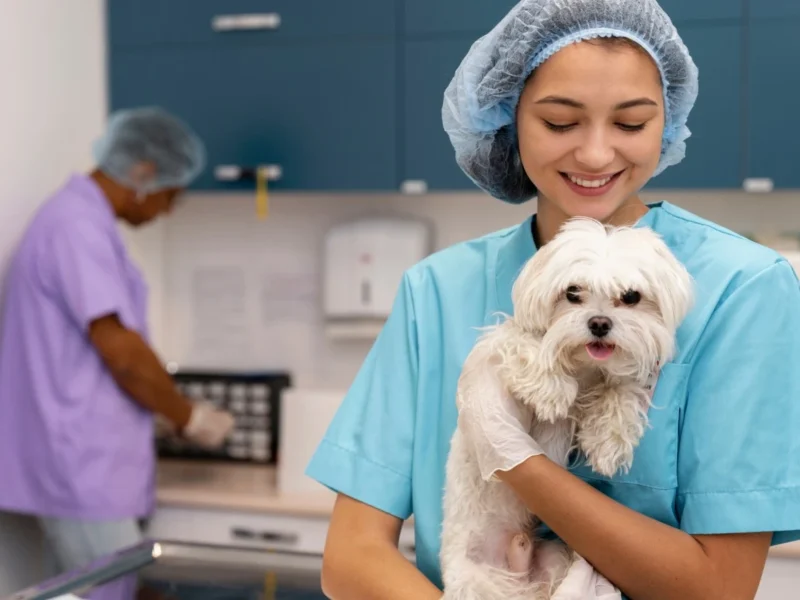Table of Contents
Pet Insurance in 2024. As a pet lover, your dog or cat is basically like a child to you. You feed, shelter, nurture, and care for them to the best of your abilities, and won’t want any kind of harm to befall them.
You also want to ensure that they are in good health, so, understandably, you would want to put in place certain protective measures that will help you care for your baby in case they ever got injured or ill, hence the need to take out a pet insurance policy.
One of the many reasons that push most pet owners to take out a pet insurance policy is the issue of vet bills. They tend to be quite significant and as a pet parent, you wouldn’t want to stand by and watch your beloved pet suffer, so you won’t have a choice but to start looking for a way to get things resolved.
Before proceeding to take out pet insurance for your furry beloved, let us take you through everything related to Pet Insurance in 2024: All You Need to Know.
Pet Insurance in 2024: What is Pet Insurance?
This is a monthly or yearly health plan meant to protect a pet owner against unforeseen cost of veterinary treatment and medical expenses if their pet falls sick or gets injured. It provides financial security and peace of mind to pet owners.
The most commonly insured animals are dogs and cats but there are insurers who cover other animals such as birds, reptiles, and so on. Pet insurance coverage varies depending on the type of policy that you choose and the types of conditions covered by the lender.
How it works is that when a pet needs medical attention for a condition that is covered by the insurance, the owner takes it to a vet, pays the full cost, and then files a claim with their insurer to recover a part of what they paid. The amount that will be reimbursed will depend on the terms of the policy.
The cost of your pet insurance usually depends on several factors including your pet’s age, gender, breed, size, location, and so on.
Most policies will often cover 70-90% of the vet bill and you would have to pay the rest out of your pocket. The portion of the vet bill covered usually depends on the type of insurance that you’ve chosen.
Terms Associated With Pet Insurance
1. Deductible: This is the part of the veterinary bill that you are personally responsible for. This is your out-of-pocket expense that you won’t get reimbursed for.
2. Reimbursement rate: This is the part of the vet bill that the insurer pays you back. This is the portion of the vet bill that your pet insurer is responsible for.
3. Premium: This is your monthly or yearly payment towards keeping your pet insurance policy on. If you need wide coverage, like the kind that can cover every treatment that your dog or cat might ever need, you will be charged a lot more compared to a pet owner who only wants to cover let’s say accident-related incidents.
What Does Pet Insurance Cover?
The point of taking out pet insurance is to prepare for unexpected occurrences regarding your pet’s well-being.
Therefore, it makes sense that you would want to know the kinds of situations that the insurance you are paying for will cover. Below are some of the situations that you can get reimbursement for, depending on the type of policy you take out with the company.
1. Accidents:
Generally, pet insurance tends to cover any kind of accident that happens to your pet. Accidents such as insect bites, poisoning, and so on, are often covered by most pet insurance.
2. Hereditary Conditions:
Some breeds are known to develop certain conditions that are associated with their kind, so if any of those illnesses arise after you’ve taken out the insurance policy, you may be able to get reimbursement for vet bills. Of course, this depends on the type of policy you have.
3. Sicknesses:
Sudden illnesses such as digestive issues are also covered by pet insurance. This way, you will be prepared to care for your pet if they develop any kind of unexpected illness.
4. Alternative treatments:
Certain conditions often warrant alternative treatments such as acupuncture and chiropractic care, so depending on the insurance plan you’ve chosen, you may be able to get reimbursement for the cost of these treatments.
5. Long-term conditions:
Certain animals are prone to a series of incurable conditions that affect body parts such as their eyes, heart, joints, and so on, as they get old. Certain plans cover the treatment of these conditions, so remember to include it in your policy.
6. Dental care:
Some policies cover the cost of dental care but only when it is necessary due to an accident or illness.
7. Loss or theft of your pet:
While taking out an insurance policy, you could include the reimbursement for the purchase price of your pet if it ever gets lost or stolen. Ensure to keep the proof of the amount you paid for the animal, or else the company might pay you the market value for your pet.
8. Liability cover:
Only available for dogs, this coverage will come in handy if your pet (dog) is ever involved in an incident where it causes injury or property damage.
9. Precautionary care:
Some plans cover the cost of taking your pet to the vet for checkups to ensure they are in good health.
10. Prescription Medication:
Many plans cover the cost of medication needed to treat the signs of covered conditions.
What Does Pet Insurance Not Cover?
The situations that a pet insurance won’t cover are as follows:
1. Pre-existing conditions: Any condition such as an injury or illness that your pet had before the policy came into effect will not be covered.
2. Breeding: Any cost relating to breeding or pregnancy is usually not covered by pet insurance.
3. Cosmetic surgeries: Unless they are essential, pet insurance doesn’t usually cover the cost of cosmetic surgeries such as ear cropping.
4. Pet liability: Not every insurer covers the cost incurred as a result of your pet injuring someone or causing damage to their property.
Types of Pet Insurance Cover
There are a different types of pet insurance policies that cover various needs. It is up to you to decide what situations you want your insurance to cover.
Lifetime Policies
This type of insurance usually covers any illness or injury that your pet develops or gets after you have taken out the policy.
There is a maximum amount that is set to cover your pet for each year, meaning if the limit is reached during the policy year, your pet won’t be covered until you renew the policy again.
Therefore, you would need to keep renewing your policy and paying your insurance premiums so your pet will remain covered regarding treatment for an illness or injury.
Accident only policies
This plan covers a portion of the cost of treatment for your beloved pet if they get injured in an accident. This doesn’t cover any accidental injury they may have sustained before the policy started.
It also doesn’t cover any illness developed by your pet, which is why it is cheaper compared to Accident and illness cover. If your pet gets injured in an accident, this plan will continue to cover them until the 12-month treatment period lapses.
This means that you need to renew your policy at the end of each period and keep paying your premiums if you want your pet to remain covered.
Accidental injuries covered by this policy include car accidents, burns, bite wounds, bone fractures, and so on.
Accident and illness cover
This policy covers a part of the treatment costs if your pet gets injured in an accident or develops a sudden illness covered by the policy. It covers accidents such as animal bites, poisoning, bee stings, swallowing of a foreign object, cuts, and so on.
It also covers illnesses such as cancer, skin conditions, heart disease, ear infections, allergies, arthritis, diabetes, diarrhoea, and so on.
Optional Cover
Certain insurance providers lets you include the cost of routine care expenses, such as vaccinations, dental care, microchipping, tick control, and so on, to your overall pet insurance.
Benefits of Getting a Pet Insurance
1. Lower expenses: Taking out a policy for your beloved pet helps you prepare for any unforeseen event, be it accidental injury or illness. This means that if your pet ever needs medical care, you won’t be taking much out of your pocket to pay for vet bills.
2. Freedom of vet choice: As long as they are certified, you are free to pick any veterinarian of your choice and file a claim with your insurance provider.
3. Numerous options to choose from: There are different types of pet insurance coverage that you can choose from, depending on your needs and financial capability. You can choose to only cover accidents or accidents and illnesses or treatment for any kind of harm that comes to your pet.
4. Quick care: Since you already know that your insurance will cover a part of the treatment costs, you won’t waste time before taking your pet to the vet to get the necessary treatment.
5. Peace of mind: Knowing your pet’s health is covered eliminates any worries regarding their well-being.
Drawbacks of Getting A Pet Insurance
1. Pre-existing conditions: If your pet has any kind of injury or illness before your insurance policy takes effect, such health issues will not be covered.
2. Pet exception: Some insurance providers don’t cover certain breeds of animals while some have a minimum and maximum age that a pet must be before it can qualify for insurance.
3. Upfront payment: Insurers usually require you to cover the full cost of veterinary services first before they reimburse you for a portion of the payment. This is a drawback if you don’t have enough money to settle the expenses upfront.
4. Excluded conditions: It is not all health conditions that pet insurers cover. Therefore, if your pet develops a health issue that your policy doesn’t cover, that is a big problem.
Mortgage Document Checklist 2024: What You Need Before Applying For A Mortgage In Canada
Factors That Determine The Cost Of Your Pet Insurance
Besides your choice of insurer, below are some of the many factors that can affect the cost of your pet insurance:
1. Age: One of the most important factors that will determine the cost of your pet insurance is your pet’s age. The older your pet, the more your insurance premium. This is because it is assumed that the older they are, the more they are prone to falling ill.
Naturally, when you take out insurance for your pet at a young age (no younger than 8 weeks), there is a chance that your premium will increase as it (your pet) grows older. Keep this tip in mind so you don’t get caught off guard in the future.
2. Breed: Another factor is what kind of breed your pet is. For example, crossbreeds are usually less prone to certain illnesses that purebreds would normally experience, so in this case, you can expect the premium for a crossbreed to be less compared to that of a purebred.
3. Size: The height and weight of your beloved pet is another factor that will determine how much your insurance premiums will be.
4. Gender: Female animals are considered less of a risk in terms of injury and sudden illnesses. They also tend to recuperate quicker when they get sick or injured. Unlike males who are known to be rambunctious, which often leads to frequent injuries. Therefore, the cost of insuring a male is higher compared to a female.
5. Location: Where you live could also determine the cost of your pet insurance. Treatment in certain areas is more expensive compared to others. Additionally, some areas are considered more risky for a pet.
6. Health condition: The health condition and medical history of your pet can also determine the cost of your pet insurance. Also, if your insurer covers pre-existing conditions, you can expect your premium to rise.
How To File An Insurance Claim With Your Pet Insurance Company
If your pet needs medical attention and you need your insurance company to cover their own portion of the medical hill, here is a simple claims filing and reimbursement process:
1. Start by arranging an appointment with a licensed and competent veterinarian or animal hospital.
2. After scheduling an appointment, take your pet to meet with the veterinarian.
3. After your pet has been attended to, settle the bill completely.
4. Once you’ve settled the bill, file a claim with the pet insurance company. This can be done online or via mail. You might also have to submit paperwork from the vet and a copy of the bill.
5. Once the pet insurer approves the claim, get your reimbursement.
The point is:
Pet insurance gives you financial protection and ensures that your darling pet is covered against illness and injury.


